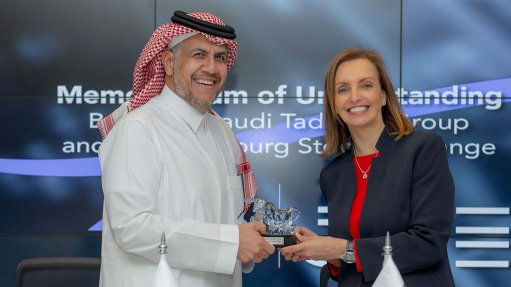Future for PGMs may not be as rosy as currently hoped
Although there have been major political developments this past month, both at home and abroad, I have decided to focus this column on a key modern technology area: hydrogen fuel cells. These are currently of great importance to South Africa because they use platinum-group metals (PGMs) and particularly platinum itself. And they are of great importance to the world because they promise to play a critically important role in decarbonising economies all around the world, especially regarding transport and mobile machinery.
And we have recently had some really upbeat and encouraging stories about this. Thus, proton exchange membrane (PEM) fuel cells using PGMs are being used by Hyundai and partners to power Xcient heavy-duty trucks in Switzerland. There are already 50 of these running on Swiss roads and the aim is for this number to increase to 1 000 by 2023 in Switzerland alone, and to 1 600 by 2025.
On a much larger scale, in a recent briefing, the Bernstein investment company asserted that, if you wanted a fuel cell, you needed platinum. And mining company Sibanye-Stilwater CEO Neal Froneman affirmed that the platinum price had only started an upward trend and that he could see no reason why it could not ultimately reach $2 000/oz or even more.
All very encouraging – indeed heady, almost intoxicating. Unfortunately, it is my unpopular duty to rain on the parade. The customers don’t want platinum or PGMs. They are very actively seeking, as far as possible, not merely to reduce but to eliminate PGMs from future green propulsion technologies. And the main customer countries are rich, developed States with sophisticated research and development (R&D) networks and large R&D budgets (both in the public and private sectors).
There are two very powerful forces driving this desire to eliminate PGM use. One is a very strong business imperative: to cut costs. Use of PGMs in fuel cells drives up costs significantly. The other force at work is less obvious, unpublicised but even more powerful: national security. The international situation has deteriorated markedly over the past few years.
According to the website of the International Platinum Group Metals Association, 58% of the world’s primary PGM production takes place in South Africa (which also holds 95% of the world’s known PGM reserves), followed by Russia with 26%. The remaining 16% of global production is split between Canada, the US and Zimbabwe. But relations between most Western powers (including Japan) and Russia are extremely poor, if not downright hostile. There is no way these countries are going to allow themselves to be dependent on Russia for PGMs. Zimbabwe is also beyond the pale. North American production and reserves are woefully inadequate to meet the anticipated needs.
So that leaves South Africa. That fact certainly assures this country great short-term benefits. But, apart from anything else, is it credible to expect rich and powerful countries to be willing to tolerate great swathes of their transport system being dependent on products from a single country?
Further, South Africa is widely perceived as being aligned with China. And over the past 18 to 24 months relations between, on the one hand, nearly all the major, and many of the minor, democratic powers and, on the other, China, have deteriorated very badly indeed. Countries which saw China as a partner as recently as two years ago now see China as an opponent and potentially an enemy. None of these democracies will wish to be dependent for strategic raw materials on a country seen as aligned with Beijing.
So what are they doing? Well, in the US, at the Department of Energy’s (DoE’s) Argonne National Laboratory, a research team is working on replacing platinum as a catalyst with a combined iron, nitrogen and carbon catalyst. Such a catalyst is created by mixing precursors containing the three elements and heating them to between 900 ºC and 1 100 ºC. The result is that iron atoms are bonded with four nitrogen atoms and imbedded in a graphene plane (a one-atom thick layer of carbon). The iron atoms are the active element: the greater the density of the iron atoms, the greater the efficiency of the electrode. This research forms part of the US government-funded Electrocatalysis Consortium (ElectroCat), which is intended to develop PGM-free catalysts for hydrogen fuel cells. This research had opened the way to the development of more stable and active PGM-free fuel cell catalysts.
But ElectroCat is also funding another research team, at Washington University, in St Louis, Missouri. This team reported in December that it had demonstrated success with a cobalt-nitrogen-carbon catalyst. Testing this catalyst in a laboratory, but in real fuel cells, they demonstrated four times the stability of the best iron, nitrogen and carbon catalysts. Moreover, the performance of the cobalt-nitrogen-carbon catalyst approached the target set by the DoE.
Meanwhile, earlier last year, an international team of researchers (from Denmark, France, Germany and the US) reported success using a tin-nitrogen-carbon fuel cell catalyst. This also demonstrated superior performance to the iron-nitrogen-carbon catalysts.
And a joint German-Japanese team is working on getting rid of PGMs by replacing PEM fuel cell technology with an ion-exchange membrane (AEM) fuel cells. These use inexpensive metals for their catalysts, not PGMs. But currently, their performance and long-term stability remains inadequate to replace PEM fuel cells. On the other hand, major advances were made in AEM technology during the period 2009–2019. It was at the end of 2019 that the researchers announced a breakthrough that promised to greatly extend the life of the membranes in AEM fuel cells. This research was funded, in part, by motor vehicle manufacturer Daihatsu (part of the Toyota group). The Japanese government also provided some of the funding.
So, South African PGM miners better make hay while the sun shines. Those smudges on the far horizon are not distant mountains, they are dark clouds. There are multiple reasons why the platinum price might not reach $2 000/oz.
Comments
Announcements
What's On
Subscribe to improve your user experience...
Option 1 (equivalent of R125 a month):
Receive a weekly copy of Creamer Media's Engineering News & Mining Weekly magazine
(print copy for those in South Africa and e-magazine for those outside of South Africa)
Receive daily email newsletters
Access to full search results
Access archive of magazine back copies
Access to Projects in Progress
Access to ONE Research Report of your choice in PDF format
Option 2 (equivalent of R375 a month):
All benefits from Option 1
PLUS
Access to Creamer Media's Research Channel Africa for ALL Research Reports, in PDF format, on various industrial and mining sectors
including Electricity; Water; Energy Transition; Hydrogen; Roads, Rail and Ports; Coal; Gold; Platinum; Battery Metals; etc.
Already a subscriber?
Forgotten your password?
Receive weekly copy of Creamer Media's Engineering News & Mining Weekly magazine (print copy for those in South Africa and e-magazine for those outside of South Africa)
➕
Recieve daily email newsletters
➕
Access to full search results
➕
Access archive of magazine back copies
➕
Access to Projects in Progress
➕
Access to ONE Research Report of your choice in PDF format
RESEARCH CHANNEL AFRICA
R4500 (equivalent of R375 a month)
SUBSCRIBEAll benefits from Option 1
➕
Access to Creamer Media's Research Channel Africa for ALL Research Reports on various industrial and mining sectors, in PDF format, including on:
Electricity
➕
Water
➕
Energy Transition
➕
Hydrogen
➕
Roads, Rail and Ports
➕
Coal
➕
Gold
➕
Platinum
➕
Battery Metals
➕
etc.
Receive all benefits from Option 1 or Option 2 delivered to numerous people at your company
➕
Multiple User names and Passwords for simultaneous log-ins
➕
Intranet integration access to all in your organisation


















